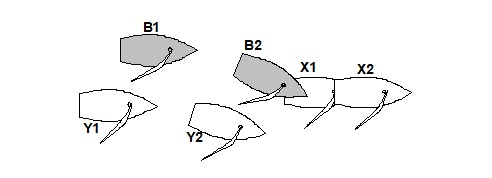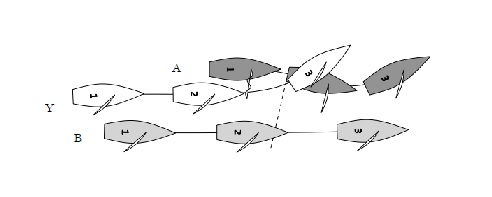


Section F - Reaching
TR CALL F2
Rule 11, On the Same Tack, Overlapped
Rule 12, On the Same Tack, Not Overlapped
Rule 19, Room to Pass an Obstruction
Rule 43, Exoneration
Definitions, Obstruction
Question 1
Three boats, Y, X and B, are reaching on proper courses. Y is approximately two
lengths directly behind X’s stern. B is overlapped to windward of Y and half a length
ahead. X slows, intending to luff B. B hails for room to pass to leeward of X and bears
away, causing Y to have to bear away to avoid her. Y protests. What should the call
be?

Answer 1
Penalize B.
X is a right-of-way boat and is therefore an obstruction to B and Y. Because Y is a
right-of-way boat with regard to B, Y may choose to pass X on either side. B must
keep clear of Y, but if Y chooses to pass X to leeward, she must give B room between
her and X. When B bears away between positions 1 and 2, she fails to keep clear as
windward boat and breaks rule 11.
Question 2
Would the answer be the same if Y is sailing a course to pass to leeward of X?
Answer 2
No. If at position 1, Y is sailing a course to pass to leeward of X then, at the point when
B needs to commit to passing to leeward of X, Y is the outside boat and must give B
room under rule 19.2(b). If she fails to do so, penalize Y. B is exonerated under rule
43.1(b) for breaking rule 11 while sailing within the room to which she is entitled under
rule 19.2.
Question 3
B and Y are sailing on a broad-reach leg and are approaching A, who is moving slowly.
Y’s bow is about half of a boat-length behind B’s bow and B is steering a course to
pass to leeward of A. At position 1, Y hails for room to pass to leeward of A. At position
2, B is overlapped to leeward of A and there is no longer room for Y to pass between
them. Y luffs to keep clear of A and protests. What should the call be?

Answer 3
No penalty. When, after position 1, boats B and Y are at the obstruction A, rule 19
requires the outside boat B to give the inside boat Y room between B and A. However,
at position 2, B is no longer required to keep clear of A and, as a result, A is no longer
an obstruction. Because A is not an obstruction, rule 19 no longer applies between B
and Y, and B is therefore no longer required to give Y room to pass to leeward of A.
Y keeps clear of B and A as required by rules 11 and 12, respectively.
Question 4
Similar to question 3, except that Y’s bow is about half of a boat-length ahead of B’s
bow and B is steering a course directly toward A’s transom. At position 2, Y becomes
overlapped to windward of A. Shortly thereafter, B bears away and passes to leeward
of A. X protests. What should the call be?

Answer 4
No penalty. Rule 19 begins to apply between positions 1 and 2 when B and Y are at
the obstruction A. Rule 19.1(a) gives B the right to choose which side to pass the
obstruction. At the time rule 19 begins to apply, neither B nor Y is outside or inside
with respect to A, and therefore rule 19.2(b) is not applicable.
At position 2, Y becomes overlapped to windward of A. Y is now the outside boat, and
must give B room to sail between her and the obstruction under rule 19.2(b) if B
chooses to do so. However, B chooses to go below A. When B becomes overlapped to
leeward of A, B becomes an obstruction to Y and A and, accordingly, Y must give A
room between her and B. Y gives A room as required by rule 19.2(b) and keeps clear
of her as required by rule 11.
Question 5
Similar to question 4, except that B and Y are steering a course to pass to leeward of
A. At position 2, Y becomes overlapped to leeward of A. A luffs to keep clear and
protests. What should the call be?

Answer 5
No penalty. B and Y are sailing a proper course and therefore do not break rule 17. At
position 1, Y keeps clear of B as required by rule 11. At position 2, Y becomes
overlapped to leeward of A. B is now an obstruction to Y and A. As the outside boat,
A must give Y room between her and B, provided that she is able to do so from the
time the overlap began. A must also keep clear of Y under rule 11. A gives room and
keeps clear by luffing.









